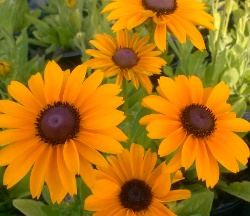Rudbeckia Tiger Eye Gold / Black Eyed Susan / Gloriosa Daisy
( Rudbeckia Hirta ‘Tiger Eye Gold’)
Black Eyed Susan Tiger Eye Gold / Gloriosa Daisy Origins:
Rudbeckia Hirta Tiger Eye Gold is a biennial or short lived herbaceous perennial plant selection.
Most often planted as an annual for the summer months and replaced with cool season annuals for the winter
season, but here in the Jacksonville | St. Augustine area landscape don’t be so quick to remove the plants once the foliage has started to decline for the winter, they may regrow quickly the following spring.
The hybrid Rudbeckia ‘Tiger Eye Gold’ is a prolific bloomer grown for its overwhelming flower display, and mildew resistance. Often touted as the best flowering Rudbeckia selection by growers.
This compact low maintenance plant is perfect for Florida’s hot summers and keeps on blooming when other flowering plants have begun to decline.
Rudbeckia Hirta Tiger Eye Gold / Gloriosa Daisy Preferred Exposure:
– Rudbeckia Hirta Tiger Eye Gold will prefer full sun or afternoon sun and morning shade exposures in the North Florida | Jacksonville | St. Augustine area gardens landscape.
Rudbeckia / Black Eyed Susan Tiger Eye Gold Foliage:
– Dark green deciduous leaves will go dormant for the winter season after fall flowering is complete. don’t toss the roots to these plants as they are likely to regrow quickly in the following spring season. Foliage is more resistant to powdery mildew than is typical of the species.
Rudbeckia Hirta Soil Preference / Salt tolerance:
– Rudbeckia Hirta / Gloriosa Daisy is not particular about the components of the soil it is planted in providing they are planted in a well draining location.
– Rudbeckia plants have a very high salt tolerance.
Rudbeckia Hirta Tiger Eye Gold Size Variance:
– Tiger Eye Rudbeckia is a compact selection only reaching 18-24 inches high and 16 -20 inches wide. Ideal for lower growing and front of the border plantings or even containers.
Rudbeckia Hirta Tiger Eye Gold Growth Habit:
– Clumping biennial / perennial plant forms an attractive compact mound of
foliage.
Rudbeckia Hirta Tiger Eye Growth Rate:
– Fast growing Rudbeckia Hirta can be expected to reach its full height in the first season and its full width by the second growth season in the North Florida | Jacksonville | St. Augustine area landscape.
Rudbeckia Hirta Black Eyed Susan Tiger Eye Gold Bloom:
– Quite possibly the most prolific of all the Rudbeckia selections so far! These black eyed Susan plants cover themselves in large 3-4 inch bright yellow gold blossoms in summer and fall.
– Rudbeckia / Black Eyed Susan blossoms make excellent cut flowers, and
removing spent blossoms promotes more blossoms so cut to your hearts content!
Gloriosa Daisy Tiger Eye Requirements:
– Plants are very drought tolerant once established in the landscape, regular water is necessary to get the plant rooted and growing on its own after being planted in the ground from a nursery container.
Butterfly or Bird Attracting:
– Rudbeckia Hirta will attract butterflies to your gardens landscape.
Best Uses For Rudbeckia Hirta in the North Florida | Jacksonville | St. Augustine
area garden:
– Rudbeckia have been a favorite of many gardeners throughout the years, and for good reason. They are a great low maintenance plant selection for loads of booms with almost no maintenance
after planting. Its low maintenance habits combined with its prolific flowering tendencies make Rudbeckia Hirta perfect addition to any well drained garden area, even hot and dry area of the garden where other plants tend to suffer.
– Plant in masses for a blooms display that cant be missed!
– Rudbeckia Hirta makes a great companion plant for other perennials in the garden and adds an instant cottage garden feel when planted in any landscape.
– Perfect for Coastal gardens where the salty soils tend to kill of other
blooming plants.
Care of Rudbeckia Hirta Tiger Eye Gold in the North Florida | Jacksonville | St. Augustine area landscape:
– Plant in well drained soils.
– Water every day during the establishment period after planting in the garden from a nursery container, once plants have established themselves into the landscape taper water back to just a weekly application if local rainfall levels are low.
– Leave foliage and roots in place for next years growth.
– Fertilize each spring with a handful of garden compost or a mixture of Milorganite and a slow release poly coated plant food such as Osmocote or Stay Green general purpose plant food or 10-10-10.


